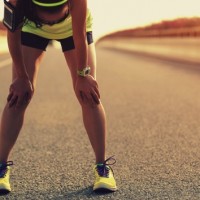
 iStock/Thinkstock(NEW YORK) — Some experts call it “hitting the wall,” others call it “the bonk”: Either way, it’s the all-around unpleasant situation when an athlete’s body shuts down even if they are in the middle of a race or competition.
iStock/Thinkstock(NEW YORK) — Some experts call it “hitting the wall,” others call it “the bonk”: Either way, it’s the all-around unpleasant situation when an athlete’s body shuts down even if they are in the middle of a race or competition.
ABC News’ own Dan Childs will show this week exactly what happens to the body when you hit the wall.
Childs, the managing editor of the ABC News Medical Unit, will run until he is crashes in an effort to show how lactic acid, carbohydrates and fat all interact to contribute to “bonking.”
Harold Pino, senior exercise physiologist at NYU Langone Medical Center’s Sports Performance Center, said that “hitting the wall” is generally thought to be the point when the body runs out of easy carbohydrates to process and will simply stop functioning properly.
This doesn’t mean your heart will give out but that you’ll feel extreme fatigue, disorientation and weakness.
“It’s when your body runs out of sugars to use as energy,” Pino told ABC News. “It’s a feeling of severe weakness and severe fatigue.”
In marathons, as people burn through hundreds to thousands of calories, their body can suddenly stop working even at the end of the race, Pino said.
“You see it at the finish line when a lot of the runners are looking at you and are really not there,” Pino explained.
Technically, it’s severely low blood sugar — hypoglycemia — that results in hitting the wall, Pino said.
“It’s like when your car runs out of fuel,” Pino told ABC News. “We can store so much carbs, and once you tap out on those carbs, you’re done.”
Hitting the wall usually happens shortly after a person reaches their “crossover point,” which is when the body switches from using carbohydrates for energy to using fat stores, Pino said. Once those carbohydrate stores are used up, an athlete can hit the wall in the span of just a few minutes, depending on how hard they are working.
It may seem impossible that marathon runners — or especially ultra-marathoners — can finish their races without hitting these walls. However these runners keep going at lower intensities, meaning they can go for miles and miles without bonking. If you work out at a maximum intensity level, you’ll crash much faster.
Elite athletes are more efficient at burning fat and therefore are able to push the “crossover point” further into their exercise so they can exercise more without risking extreme fatigue, Pino noted.
Amateur athletes or runners hoping to use this to eat a giant meal or stock up on snacks before a run should be warned that this really only applies after at least an hour of working out. People training more than an hour should consider having a snack to ward off the bonk, Pino said.
An athlete can also hit the wall when they build up too much lactic acid in their muscles. The acid builds up naturally in the body, but during intense exercise, the body produces higher levels than it can process. This causes the familiar burning sensation in muscles during a workout.
This kind of “bonk” is a little different than the one caused by the “crossover point.” This kind of hitting the wall fatigues the muscles so that the acid can be processed by the body. Dan Childs will push through the lactic acid buildup to hit the carb-depletion wall.
And it might not be pretty.
Copyright © 2016, ABC Radio. All rights reserved.















